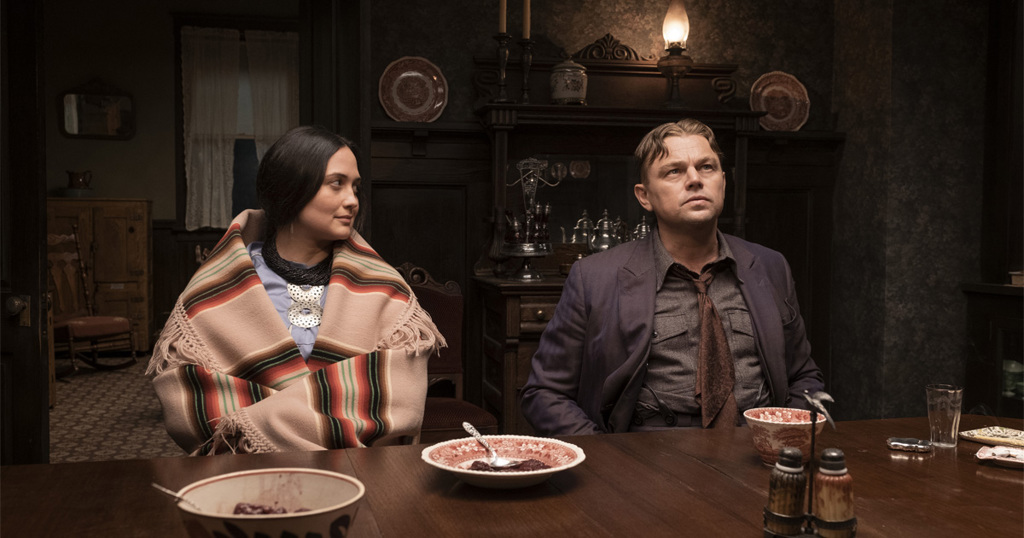Score: 5/5
Warning: Minor Spoilers Ahead
Martin Scorsese’s Killers of the Flower Moon is a towering achievement of cinema and the most important film released in a long time.
Traversing an extensive 3 ? hour runtime, Killers flaunts all the cinematic elements of Scorsese’s films, especially continuing the grandiosity of his most recent picture prior to this one, 2019’s The Irishman.
Killers is visually captivating, narratively gigantic and full of nuanced and commanding performances. Likewise, there is something unique about how the film veers off course from Scorsese’s usual formula of storytelling that beckon viewers to reflect on the film unlike how they have with his other works.
Blending elements of a documentary-style presentation with historical drama, the film recounts the events that took place during the 1920s in the Osage nation. Previously believing their land to be infertile, the Osage people soon learned that their land was rich with oil, making their people some of America’s wealthiest.
Such immense wealth attracted outsiders, including the film’s protagonist Ernest Burkhart (Leonardo DiCaprio), a former chef in the war, and his uncle William King Hale (Robert DeNiro), who serves as a deputy sheriff and local businessman. Due to the law protecting the Osage’s right to their wealth, Hale and other outsiders conspire to ensure the wealth falls into their hands through any means necessary, including eventual murder.
DiCaprio soars to a summit above his previous work. Being a poster boy of Hollywood from the early days of his career, it’s admirable to witness him set aside his icon status to portray a morally questionable, but at times sympathetic character, that is nonetheless despicable at large. Despite several major leading roles under his belt, DiCaprio manages to become truly chameleonic as Burkhart.
Any reactions of unease and disgust towards Burkhart’s character are completely dwarfed by DeNiro’s performance as William King Hale, the orchestrator behind the Osage murder plot. The greatest horror behind DeNiro’s role as Hale is the casual nature in which he implies murder constantly, but never outright says it, carefully shrouding his words in charisma. It’s a psychologically violent and unsettling depiction of the true evil that serves as the bitter core of the film.
Lily Gladstone offers a standout performance of the year. Her portrayal of Osage member Mollie Burkhart is both commanding and vulnerable as she quietly dominates every scene with a subdued austerity. Burkart’s story as the wife of Ernest during the Osage murders was heartbreaking; capturing it in a respectful performance was going to be a challenging task for any actor, but Gladstone hit the nail on the head. Furthermore, her delicate performance ultimately brings to light the resilience and pride of the Osage people, showing their indomitable spirit.
Likely what will deter people most from viewing Killers in theatres is its gargantuan runtime. However, the film surprisingly makes use of pacing perfectly, feeling shorter than it is. The length of a film’s runtime in comparison to how long it feels for viewers is proportional to choices made in editing. Longer takes – particularly dialogue heavy ones – without any cuts may feel longer and less “snappy,” demanding more attention from audiences. Conversely, short movies may also feel longer simply due to editing choices, thus a long movie shouldn’t be discredited for its runtime alone, especially in the case of Killers.
Editor Thelma Schoonmaker demonstrates her astute awareness of editing’s power on Killers. With scenes of heavy expository dialogue cutting abruptly to harrowingly fast scenes of murder, she successfully ensures that every minute feels warranted, and no line feels verbose.
Aiding the film’s pacing is the score composed by Robbie Robertson. The soft minimalist blues lead by the deep groan of a bass slithers its way through scenes, frequently lingering in the background for several minutes at a time. It’s far from boisterous but is a necessity for instilling the near-constant dread coating the story.
The film industry soars like an arrow constantly redirected by the winds of changing times. As one of the industry’s exemplary filmmakers, Scorsese’s cinematic formulas have shifted directions multiple times, nevertheless being characterized by his dedication to crafting ambitious and narratively engaging films.
Atop the many completed films over the course of Scorsese’s career, Killers of the Flower Moon stands apart from its predecessors. By numerous metrics, it satisfies the criteria of a Scorsese epic, but what sets it apart is its added layer of self-awareness revealed at the ending. Along with recounting the events of the Osage murders, there are points in the film that suggest the accountability of crime storytelling itself. In its final scene, Killers examines itself from another angle, reflecting on how stories about true crime are shared on an entertainment level.
From a bird’s-eye view, Scorsese knows that Killers is a movie, making it a vessel for entertainment. True crime is a genre that exploits the morbid curiosity for tragedy and how heinous acts can be committed. The genre is often marketed directly towards people who exist outside these tragedies, who consume them as a form of entertainment at the expense of those involved.
Killers of the Flower Moon is an enormous work of historical cinema, but what brings it to a higher level is how it reflects on the way we retell history. Historical tragedies’ depiction through an entertaining recasting of the events themselves, such as film, often redirects attention from those involved to the level of enjoyment the consumers received.
Albeit rather bleak, this sentiment offers a glimmer of hope and a call for change: until we endure the pains of past tragedies, they will continue to exist as empathetically disconnected retellings for audiences to passively consume. And Killers of the Flower Moon, while successfully being an entertaining and engaging film, doesn’t leave its audience as passive consumers but empathetically active viewers.


